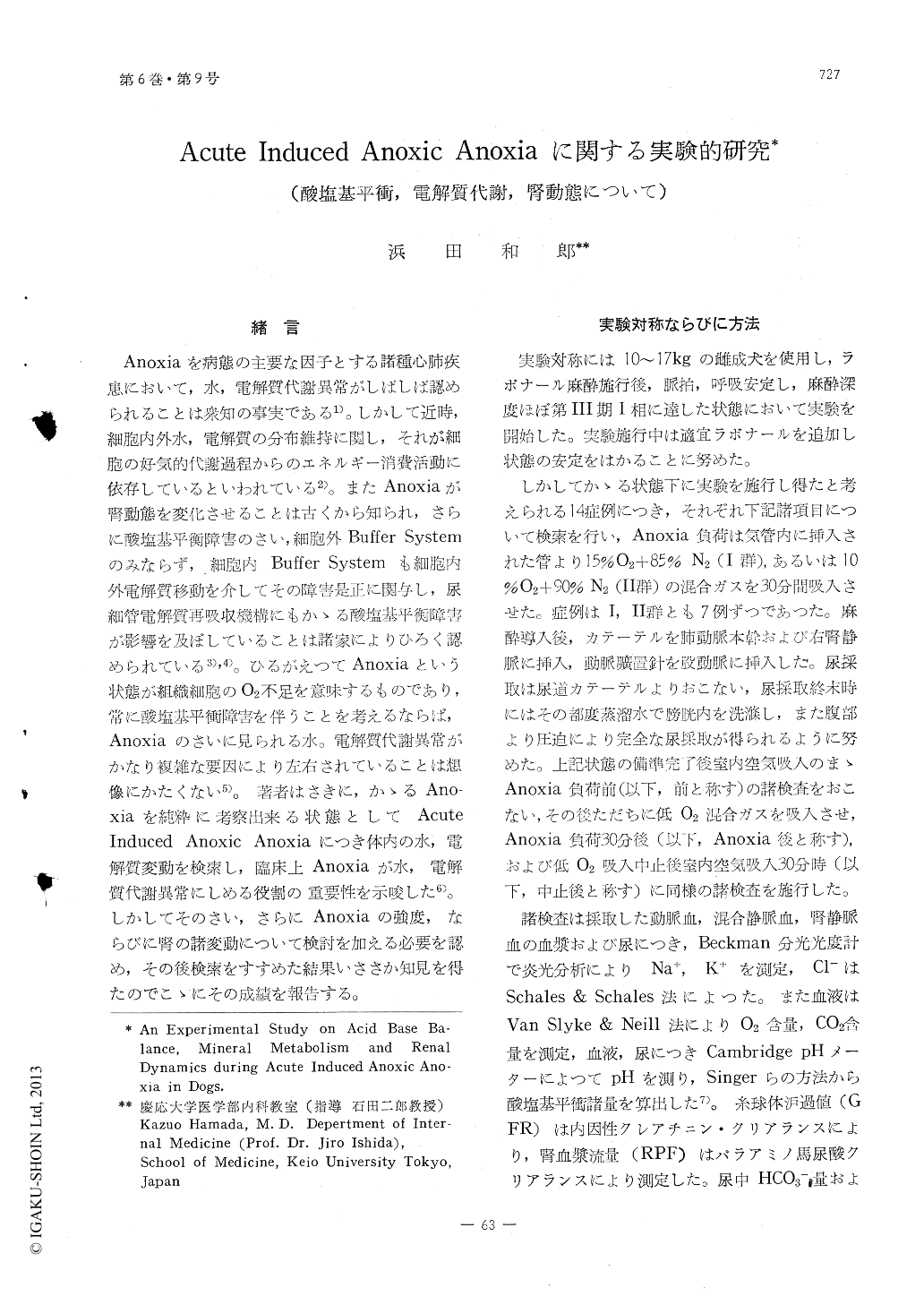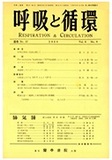Japanese
English
- 有料閲覧
- Abstract 文献概要
- 1ページ目 Look Inside
緒言
Anoxiaを病態の主要な因子とする諸種心肺疾患において,水,電解質代謝異常がしばしば認められることは衆知の事実である1)。しかして近時,細胞内外水,電解質の分布維持に関し,それが細胞の好気的代謝過程からのエネルギー消費活動に依存しているといわれている2)。またAnoxiaが腎動態を変化させることは古くから知られ,さらに酸塩基平衡障害のさい,細胞外Buffer Systemのみならず,細胞内Buffer Systemも細胞内外電解質移動を介してその障害是正に関与し,尿細管電解質再吸収機構にもかゝる酸塩基平衡障害が影響を及ぼしていることは諸家によりひろく認められている3),4)。ひるがえつてAnoxiaという状態が組織細胞のO2不足を意味するものであり,常に酸塩基平衝障害を伴うことを考えるならば,Anoxiaのさいに見られる水。電解質代謝異常がかなり複雑な要因により左右されていることは想像にかたくない5)。著者はさきに,かゝるAno—xiaを純粋に考察出来る状態としてAcuteInduced Anoxic Anoxiaにつき体内の水,電解質変動を検索し,臨床上Anoxiaが水,電解質代謝異常にしめる役割の重要性を示唆した6)。しかしてそのさい,さらにAnoxiaの強度,ならびに腎の諸変動について検討を加える必要を認め,その後検索をすすめた結果いささか知見を得たのでこゝにその成績を報告する。
To clarify the effects of acute induced anoxic anoxia on acid base balance, mineral metabolism, renal hemcdynamics and renal tubular reabsorption, cardiac and renal catheterization were carried out on 14 dogs, composing of 7 cases of 15% O2 anoxia (Croup I) and 7 cases of 10% O2 anoxia (Group Ⅱ), respectively. The data were obtained before and at 30 min. anoxia and 30 min. after recovery.
The results were as follows:
Respiratory alkalosis was obserbed on arterial blood in Group I, and at the same time, acid base balance of mixed vonous blood suggested the sign of anoxic state in tissue. While in Group II, mixed venous blood showed metabolic acidosis which means more severe anoxic state in tissue than in Group Ⅰ. From the changes in Pco2 of arterial and mixed venous in Group Ⅱ, in severe anoxic anoxia, development of respiratory acidosis was considered in addition to metabolic acidosis.
In both groups, sodium was delivered from intracellular, to extrcellular space, and though movement of potassium was not significant in Group Ⅰ, it was clearly seen in Group Ⅱ that potassium was flowed out from intracellular to extracellular space.
Urinary pH, GFR, RPF and renal excretion of sodium and potassium were indreased in Group I, while in Group Ⅱ, these changes were reversed and also urinary volume and excretion of chlorid were decreased. Tubular reabsorption of sodium was slightly increased and that of bicarbonate was decreased in Group Ⅰ but in Group Ⅱ, sodium and bicarbonate reabsorption were increased.
Cardiac output and pulmonarry artery pressure were increased in both groups. Changes in renal venous pressure was insignificant in Group Ⅰ, but slightly elevated in Group Ⅱ. Renal O2 consumption was increased in Group Ⅰ, but decreased in Group Ⅱ. Difference of arterio-venous CO2 content was decreased in Group Ⅰ, but not significant in Group Ⅱ.
From these results, it is emphasized that anoxia may be one of important causes of edema in clinical conditions.

Copyright © 1958, Igaku-Shoin Ltd. All rights reserved.


